英语模拟试题ddd
- 格式:doc
- 大小:230.00 KB
- 文档页数:50
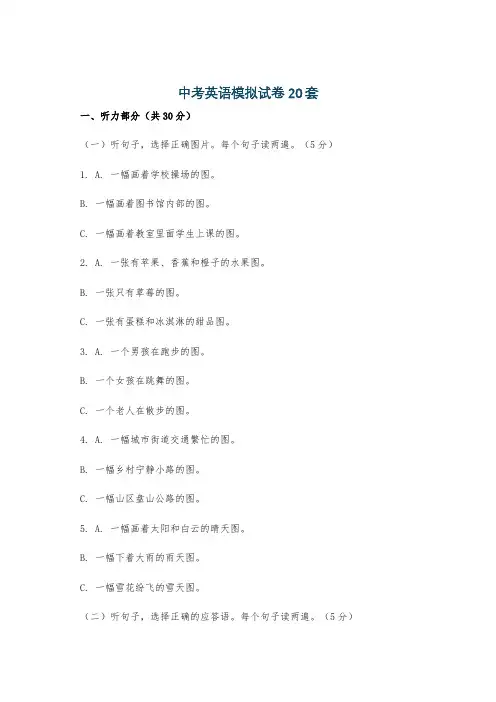
中考英语模拟试卷20套一、听力部分(共30分)(一)听句子,选择正确图片。
每个句子读两遍。
(5分)1. A. 一幅画着学校操场的图。
B. 一幅画着图书馆内部的图。
C. 一幅画着教室里面学生上课的图。
2. A. 一张有苹果、香蕉和橙子的水果图。
B. 一张只有草莓的图。
C. 一张有蛋糕和冰淇淋的甜品图。
3. A. 一个男孩在跑步的图。
B. 一个女孩在跳舞的图。
C. 一个老人在散步的图。
4. A. 一幅城市街道交通繁忙的图。
B. 一幅乡村宁静小路的图。
C. 一幅山区盘山公路的图。
5. A. 一幅画着太阳和白云的晴天图。
B. 一幅下着大雨的雨天图。
C. 一幅雪花纷飞的雪天图。
(二)听句子,选择正确的应答语。
每个句子读两遍。
(5分)1. A. Fine, thank you.B. How do you do?C. Nice to meet you.2. A. It's Monday.B. It's June 10th.C. It's 9 o'clock.3. A. Yes, I can.B. No, I'm not.C. Yes, I do.4. A. I like reading.B. I'm reading a book.C. I read a book yesterday.5. A. By bike.B. For two hours.C. About 5 kilometers.(三)听对话,选择正确答案。
每段对话读两遍。
(10分)1. What does the boy want to be in the future?A. A doctor.B. A teacher.C. An engineer.2. Where are they talking?A. In a library.B. In a bookstore.C. In a classroom.3. How often does the girl go to the English corner?A. Once a week.B. Twice a week.C. Three times a week.4. What's the matter with the man?A. He has a headache.B. He has a toothache.C. He has a stomachache.5. What color does the woman like best?A. Red.B. Blue.C. Green.(四)听短文,根据短文内容完成表格。
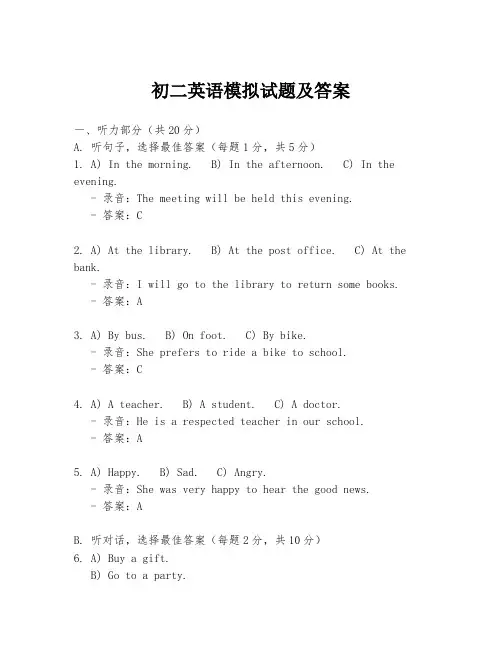
初二英语模拟试题及答案一、听力部分(共20分)A. 听句子,选择最佳答案(每题1分,共5分)1. A) In the morning. B) In the afternoon. C) In the evening.- 录音:The meeting will be held this evening.- 答案:C2. A) At the library. B) At the post office. C) At the bank.- 录音:I will go to the library to return some books. - 答案:A3. A) By bus. B) On foot. C) By bike.- 录音:She prefers to ride a bike to school.- 答案:C4. A) A teacher. B) A student. C) A doctor.- 录音:He is a respected teacher in our school.- 答案:A5. A) Happy. B) Sad. C) Angry.- 录音:She was very happy to hear the good news.- 答案:AB. 听对话,选择最佳答案(每题2分,共10分)6. A) Buy a gift.B) Go to a party.C) Visit a museum.- 对话:W: What are you planning to do this weekend? M:I'm going to a birthday party.- 答案:B7. A) He forgot his keys.B) He lost his wallet.C) He broke his phone.- 对话:W: Why is Tom so upset? M: He lost his wallet on the bus.- 答案:B8. A) In a restaurant.B) In a classroom.C) In a bookstore.- 对话:W: Can I help you with anything? M: Yes, I'm looking for a cookbook.- 答案:C9. A) She is going to the beach.B) She is going to the mountains.C) She is going to the countryside.- 对话:W: Where is Lily going for her vacation? M: She plans to go to the countryside.- 答案:C10. A) He will take a train.B) He will take a plane.C) He will take a bus.- 对话:W: How will you travel to New York? M: I'll take a train.C. 听短文,回答问题(每题2分,共5分)11. What is the main topic of the passage?- 短文:The passage talks about the importance of recycling.- 答案:The importance of recycling.12. What can be recycled according to the passage?- 短文:Paper, glass, and plastic can be recycled.- 答案:Paper, glass, and plastic.13. What is the benefit of recycling mentioned in the passage? - 短文:Recycling helps to save natural resources and reduce pollution.- 答案:Saving natural resources and reducing pollution.二、语法和词汇部分(共30分)A. 单项选择(每题1分,共15分)14. The teacher asked the students ________ in class.A) don't talk B) not talk C) not to talk D) to not talk- 答案:C15. She _______ her keys in the office, so she had to waituntil someone found them.A) lost B) missed C) forgot D) left- 答案:D16. -What's your favorite _______?- Music. I like listening to it every day.A) subject B) hobby C) color D) sport17. The little girl is too young _______ to school.A) go B) to go C) going D) gone- 答案:B18. -Can you help me with my English?- Sure, I'd love _______.A) to B) that C) it D) this- 答案:C19. They _______ the housework last weekend.A) did B) do C) makes D) made- 答案:D20. -What's the weather like tomorrow?- It _______ rain.- 答案:A) is going to21. -Would you like to go to the concert with me? - I'd love to, but I _______.A) mustn't B) can't C) shouldn't D) needn't- 答案:B。
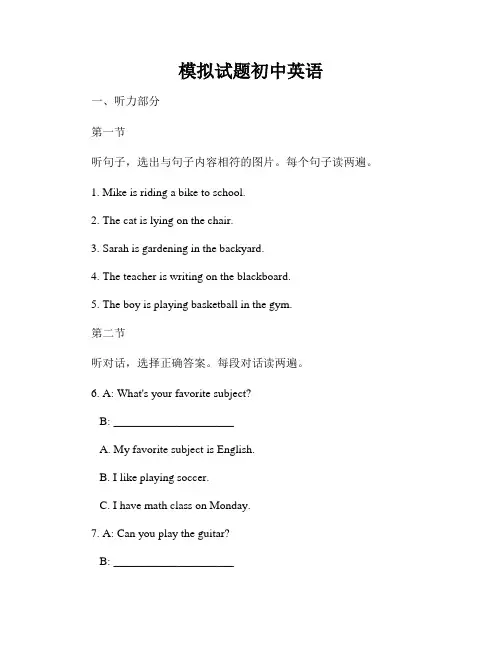
模拟试题初中英语一、听力部分第一节听句子,选出与句子内容相符的图片。
每个句子读两遍。
1. Mike is riding a bike to school.2. The cat is lying on the chair.3. Sarah is gardening in the backyard.4. The teacher is writing on the blackboard.5. The boy is playing basketball in the gym.第二节听对话,选择正确答案。
每段对话读两遍。
6. A: What's your favorite subject?B: _____________________A. My favorite subject is English.B. I like playing soccer.C. I have math class on Monday.7. A: Can you play the guitar?B: _____________________A. No, I can't play the guitar.B. Yes, I can. I play it every day.C. I like singing.8. A: What are you going to do this weekend? B: _____________________A. I'll go shopping with my friends.B. I bought a new book yesterday.C. I'm reading a novel now.9. A: How do you go to school every day?B: _____________________A. By bike.B. I got up at 7 this morning.C. I go to school with my sister.10. A: What does your sister look like?B: _____________________A. She has long black hair.B. She is good at playing the piano.C. She likes watching movies.第三节听独白,选择正确答案。
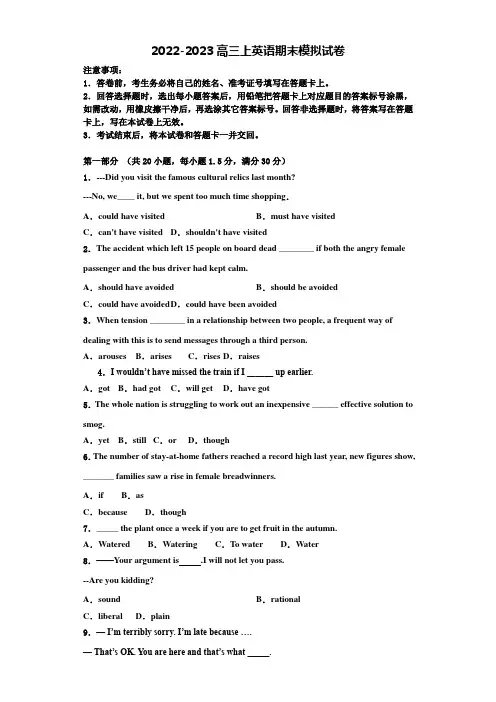
2022-2023高三上英语期末模拟试卷注意事项:1.答卷前,考生务必将自己的姓名、准考证号填写在答题卡上。
2.回答选择题时,选出每小题答案后,用铅笔把答题卡上对应题目的答案标号涂黑,如需改动,用橡皮擦干净后,再选涂其它答案标号。
回答非选择题时,将答案写在答题卡上,写在本试卷上无效。
3.考试结束后,将本试卷和答题卡一并交回。
第一部分(共20小题,每小题1.5分,满分30分)1.---Did you visit the famous cultural relics last month?---No, we____ it, but we spent too much time shopping.A.could have visited B.must have visitedC.can't have visited D.shouldn't have visited2.The accident which left 15 people on board dead ________ if both the angry female passenger and the bus driver had kept calm.A.should have avoided B.should be avoidedC.could have avoided D.could have been avoided3.When tension ________ in a relationship between two people, a frequent way of dealing with this is to send messages through a third person.A.arouses B.arises C.rises D.raises4.I wouldn’t have missed the train if I ______ up earlier.A.got B.had got C.will get D.have got5.The whole nation is struggling to work out an inexpensive ______ effective solution to smog.A.yet B.still C.or D.though6.The number of stay-at-home fathers reached a record high last year, new figures show, _______ families saw a rise in female breadwinners.A.if B.asC.because D.though7._____ the plant once a week if you are to get fruit in the autumn.A.Watered B.Watering C.To water D.Water8.——Your argument is .I will not let you pass.--Are you kidding?A.sound B.rationalC.liberal D.plain9.—I’m terribly sorry. I’m late because ….—That’s OK. Y ou are here and that’s what _____.A.does B.works C.functions D.counts10.Mary became ______ homesick and critical of the United States, so she fled from her home in West Bloomfield to her hometown in Austria.A.completely B.sincerelyC.approximately D.increasingly11.In spite of _________ has been said, quite a lot of people are still uncertain about the state of the country’s economy.A.what B.whichC.that D.as12.-Are you ready for the history test tomorrow?-No,I wish I_____the clock back.A.had turned B.could turnC.will turn D.would have turned13.I live in a town ______ runs a small and winding river.A.through which B.which C.in which D.where14.The necklace the woman bought is , because it is made of glass. A.priceless B.worthwhile C.valuable D.worthless15.--- I’m afraid the com pany will not hire me.--- Come on, Bill, relax! Y ou have a lot of experience and fine references and your college work is ideal background for them. ______________A.It'll be no sweat. B.All good things come to an end.C.Words pay no debts. D.Don't give me any jaw.16.He was forced to spend another night at the airport ____ for his plane. A.waiting B.being waited C.waited D.to be waited17.It’s natural that I didn’t recognize her immediately I saw her. _______, it’s almost 5 years since we met last.A.After all B.In addition C.What’s more D.In particular18.I owe my current success to David, my best friend since childhood, without whom I have no idea where I ________ today.A.am B.wasC.would have been D.would be19.After talking with her teacher for about an hour, she felt relieved and began to know how to this kind of situation.A.handle B.raise C.explore D.strengthen20.English is a language shared by several diverse cultures, _________ uses itdifferently.A.all of which B.each of which C.all of them D.each of them第二部分阅读理解(满分40分)阅读下列短文,从每题所给的A、B、C、D四个选项中,选出最佳选项。
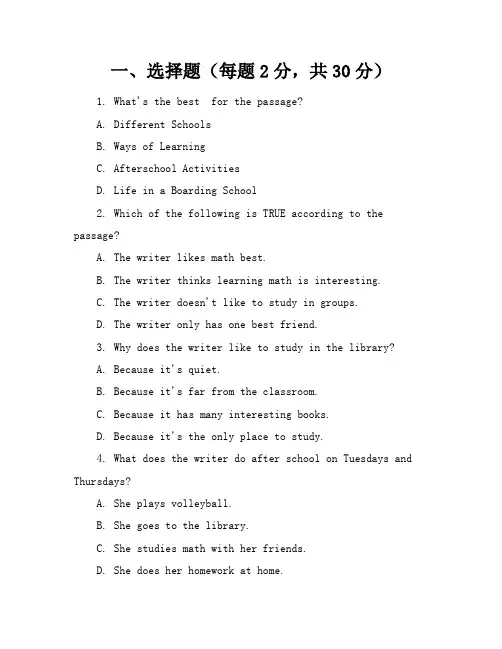
一、选择题(每题2分,共30分)1. What's the best for the passage?A. Different SchoolsB. Ways of LearningC. Afterschool ActivitiesD. Life in a Boarding School2. Which of the following is TRUE according to the passage?A. The writer likes math best.B. The writer thinks learning math is interesting.C. The writer doesn't like to study in groups.D. The writer only has one best friend.3. Why does the writer like to study in the library?A. Because it's quiet.B. Because it's far from the classroom.C. Because it has many interesting books.D. Because it's the only place to study.4. What does the writer do after school on Tuesdays and Thursdays?A. She plays volleyball.B. She goes to the library.C. She studies math with her friends.D. She does her homework at home.5. What's the writer's feeling about her life in the boarding school?A. BoredB. HappyC. TiredD. Lonely二、判断题(每题1分,共20分)6. The writer likes to study in groups. ( )7. The writer thinks learning math is the most difficult. ( )8. The writer has many best friends in the boarding school. ( )9. The writer often goes to the library to read interesting books. ( )10. The writer thinks her life in the boarding school is boring. ( )三、填空题(每空1分,共10分)11. The writer likes to study in the ________ becauseit's quiet.12. The writer thinks learning ________ is the most difficult.13. The writer has many good friends, but only one________.14. The writer often goes to the library to read ________ books.15. The writer thinks her life in the boarding school is very ________.四、简答题(每题10分,共10分)16. Why does the writer like to study in the library?17. What does the writer do after school on Mondays, Wednesdays, and Fridays?五、综合题(1和2两题7分,3和4两题8分,共30分)18. Read the following passage and answer the questions.Passage:My name is Lucy. I am a student in a boarding school. I like my school very much because I have many good friends there. We often study and play together. I think learning math is the most difficult, but my friends help me a lot. We often study in groups and discuss the difficult problems together. After school, we often play volleyball or basketball together. On weekends, we often go to the library to read interesting books. I think my life in the boarding school is very happy.Questions:1. What's Lucy's feeling about her life in the boarding school?2. Why does Lucy like to study in groups?3. What does Lucy do after school on weekends?4. Does Lucy think learning math is easy or difficult? Why?(考试时间:90分钟,满分:100分)三、填空题(每空1分,共10分)11. In the morning, students should arrive at school before the ________ bell rings.12. The teacher asked us to ________ our homework on the desk for her to check.13. If you want to improve your English, it's important to practice ________ every day.14. The ________ of the school is very strict; all students must follow the rules.15. During the break, students can go to the ________ to get something to eat or drink.四、简答题(每题10分,共10分)16. Describe the main difference between a state school and a private school.17. Explain why some students prefer to study in the library instead of the classroom.五、综合题(1和2两题7分,3和4两题8分,共30分)18. Read the following passage and answer the questions.Passage:Many students find it challenging to balance their academic workload with their personal interests. Some students are involved in sports, music, or other extracurricular activities, which can take up a significant amount of their time. Finding a balance between studying and pursuing personal interests is important for maintaining a healthy lifestyle and reducing stress.Questions:1. What is the main challenge that students face when trying to balance their academic workload with personal interests?2. How can students manage their time more effectively to achieve this balance?3. What are some benefits of being involved in extracurricular activities alongside academic studies?4. Can you suggest any time management techniques that students can use to ensure they have enough time for both studying and personal interests?六、词汇题(每题3分,共15分)The teacher asked us to ________ our essays to improve our writing skills.A. reviseB. rewriteC. edit20. Fill in the blank with the correct form of the word:The ________ of the school is planning to implement new teaching methods next year.A. principalB. principleC. palaceD. penguin21. Match the words with their definitions:I. Vocabulary1. Implement2. Principle3. Extracurricular4. Balance5. ReduceII. DefinitionsA. To make something active or effectiveB. A fundamental truth or beliefC. Activities that are not part of the regular curriculumD. To find a middle point between two thingsE. To make something smaller in size, amount, or degree22. Choose the correct synonym for the word "challenging":B. DifficultC. BoringD. Exciting23. Choose the correct antonym for the word "strict":A. LazyB. LenientC. ActiveD. Serious七、阅读理解题(每题5分,共25分)Read the following text and answer the questions.Text:Many students find it challenging to balance their academic workload with their personal interests. Some students are involved in sports, music, or other extracurricular activities, which can take up a significant amount of their time. Finding a balance between studying and pursuing personal interests is important for maintaining a healthy lifestyle and reducing stress.Questions:24. What is the main idea of the second paragraph?25. Why do some students find it difficult to balance their academic workload with personal interests?26. What are two benefits of being involved in extracurricular activities alongside academic studies?27. What is the author's purpose in writing this text?八、写作题(1题15分)28. Write a short essay (about 150200 words) on the topic "The Importance of Time Management for Students."九、听力题(每题4分,共20分)29. Listen to the following conversation and answer the questions.Conversation:A: Hey, how was your day at school?B: It was okay, but I have a lot of homework to do tonight.A: Me too. I also have a basketball game later.B: How do you manage to do everything?A: I prioritize my tasks and use a planner to stay organized.B: That's a good idea. I should try that too.Questions:30. What does the first person have to do after school?31. What suggestion does the second person give for managing tasks?32. What is the main topic of the conversation?十、语法题(每题3分,共15分)If it ________ tomorrow, we will stay at home and study.A. rainsB. rainC. will rainD. rained34. Identify the error in the一、选择题答案:1. B2. C3. A4. C5. B二、判断题答案:6. ×7. √8. √9. ×10.×三、填空题答案:11. morning12. hand in13. speaking14. discipline15. canteen四、简答题答案:16. State schools are funded the government and are free for students to attend, while private schools are funded tuition fees and are not free.17. Some students prefer to study in the library becauseit is quieter and they can focus better without distractions.五、综合题答案:18.2. Students can manage their time more effectively creating a schedule, setting priorities, and avoiding procrastination.3. Benefits include developing new skills, making friends, and reducing stress.4. Time management techniques include using planners, setting goals, and breaking tasks into smaller, manageable parts.六、词汇题答案:19. A20. A21. 1D, 2B, 3C, 4A, 5E22. B23. B七、阅读理解题答案:24. The main idea is that finding a balance between academic workload and personal interests is important for maintaining a healthy lifestyle and reducing stress.25. Some students find it difficult to balance their academic workload with personal interests because extracurricular activities can take up a significant amount of their time.26. Two benefits are developing new skills and making friends.27. The author's purpose is to inform students about the importance of finding a balance between academic workload and personal interests.The Importance of Time Management for StudentsTime management is an essential skill for students to learn in order to achieve their academic goals. With proper time management, students can balance their academic workload with personal interests, reduce stress, and improve their overall efficiency.One of the main benefits of time management is that it helps students prioritize their tasks. By identifying which tasks are most important and scheduling them accordingly, students can ensure that they allocate enough time for their academic work. Additionally, time management helps studentsavoid procrastination, which can lead to unnecessary stress and poor performance.In conclusion, time management is a crucial skill for students to develop in order to achieve their academic goals while maintaining a healthy lifestyle and pursuing personal interests.九、听力题答案:30. The first person has a basketball game after school.31. The second person suggests using a planner to stay organized.32. The main topic of the conversation is managing tasks and priorities.十、语法题答案:33. A34. The error in the sentence is the incorrect use of the future tense. The correct verb form should be "rains" (A).一、选择题:主要考察学生对英语词汇、语法和阅读理解能力的掌握。
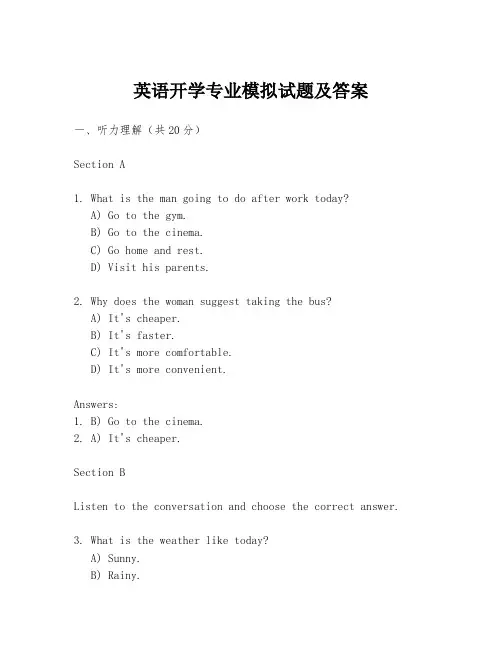
英语开学专业模拟试题及答案一、听力理解(共20分)Section A1. What is the man going to do after work today?A) Go to the gym.B) Go to the cinema.C) Go home and rest.D) Visit his parents.2. Why does the woman suggest taking the bus?A) It's cheaper.B) It's faster.C) It's more comfortable.D) It's more convenient.Answers:1. B) Go to the cinema.2. A) It's cheaper.Section BListen to the conversation and choose the correct answer.3. What is the weather like today?A) Sunny.B) Rainy.C) Cloudy.D) Snowy.4. What does the man plan to do this weekend?A) Go hiking.B) Stay at home.C) Go to a concert.D) Travel abroad.Answers:3. C) Cloudy.4. A) Go hiking.二、阅读理解(共30分)Passage 1In recent years, the popularity of online shopping has skyrocketed. People from all walks of life are now able to purchase a wide variety of products with just a few clicks of a mouse. However, with the convenience comes the challenge of ensuring the security of online transactions.Questions:5. What is the main topic of the passage?A) The history of online shopping.B) The popularity of online shopping.C) The challenges of online transactions.D) The benefits of online shopping.6. What does the passage imply about online shopping?A) It is only popular among young people.B) It is becoming increasingly popular.C) It is only safe if done in person.D) It is not as popular as traditional shopping.Answers:5. B) The popularity of online shopping.6. B) It is becoming increasingly popular.Passage 2The concept of a "smart city" has been gaining traction globally. A smart city uses technology to enhance the quality and performance of urban services, to reduce costs and resource consumption, and to engage more effectively with its citizens.Questions:7. What is a smart city?A) A city with a lot of green spaces.B) A city that uses technology to improve services.C) A city with a high population density.D) A city with a lot of historical buildings.8. What are the benefits of a smart city according to the passage?A) Reduced costs and resource consumption.B) Increased pollution.C) Decreased quality of services.D) Less engagement with citizens.Answers:7. B) A city that uses technology to improve services.8. A) Reduced costs and resource consumption.三、完形填空(共20分)Read the following passage and fill in the blanks with the most suitable word from the options provided.In the past, people used to rely on maps to find their way around. Nowadays, with the advent of GPS technology, getting lost has become a rare occurrence. However, there are still times when a traditional map can be 9.A) usefulB) necessaryC) outdatedD) irrelevant10. Despite the convenience of GPS, some people still prefer to use maps because they find them 11.A) more reliableB) more challengingC) more educationalD) more entertainingAnswers:9. B) necessary10. A) more reliable四、语法填空(共15分)For each numbered blank, fill in the correct form of the word given in brackets.The Internet has revolutionized the way we communicate. It allows us to send messages instantly and 12 (connect) with people from all over the world.12. connect五、翻译(共15分)Translate the following sentences from English to Chinese.13. The company is committed to providing high-quality products and services.公司致力于提供高质量的产品和服务。
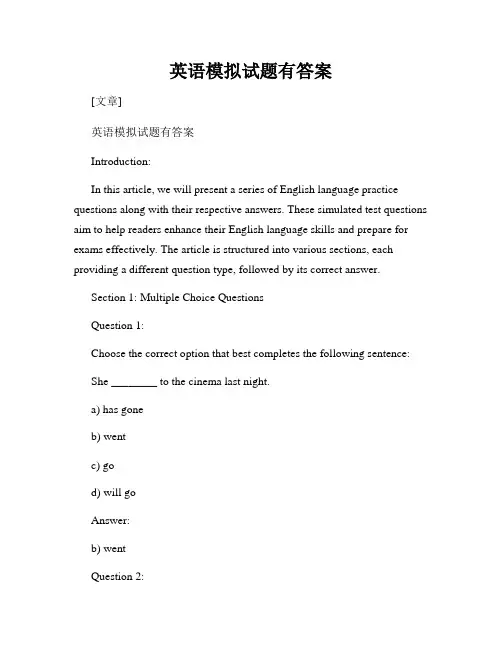
英语模拟试题有答案[文章]英语模拟试题有答案Introduction:In this article, we will present a series of English language practice questions along with their respective answers. These simulated test questions aim to help readers enhance their English language skills and prepare for exams effectively. The article is structured into various sections, each providing a different question type, followed by its correct answer.Section 1: Multiple Choice QuestionsQuestion 1:Choose the correct option that best completes the following sentence:She ________ to the cinema last night.a) has goneb) wentc) god) will goAnswer:b) wentQuestion 2:Which of the following words is the opposite of "brave"?a) courageousb) timidc) fearlessd) strongAnswer:b) timidSection 2: Fill in the BlanksQuestion 3:Complete the following sentence by filling in the appropriate word: ______ you like to have dinner with me tomorrow?Answer:WouldQuestion 4:Fill in the gap with the correct phrasal verb:He suddenly ________ after hearing the unexpected news. Answer:broke downSection 3: Sentence TransformationQuestion 5:Rewrite the following sentence using the given word:"The cat is on the mat." (BEGIN: "On...")Answer:On the mat, there is a cat.Question 6:Rewrite the sentence using the passive voice:They built a new school in our town.Answer:A new school was built in our town (by them).Section 4: Reading ComprehensionPassage:Read the following passage and answer the questions below.The Importance of Reading BooksReading books provides numerous benefits to individuals of all ages. It enhances vocabulary, promotes critical thinking skills, and nurtures imagination. Moreover, reading books can be a source of relaxation and stress reduction. It is a hobby that broadens horizons and exposes us to different cultures and perspectives.Question 7:What are some benefits of reading books?Answer:Some benefits of reading books include enhanced vocabulary, improved critical thinking skills, nurtured imagination, and exposure to different cultures.Question 8:In addition to enhancing vocabulary, what else can reading books contribute to?Answer:Reading books contributes to promoting critical thinking skills, nurturing imagination, relaxation, and stress reduction.Conclusion:By providing a series of English language practice questions and their answers, this article aimed to help readers improve their English skills and enhance their exam preparation. By familiarizing themselves with different question types and their correct answers, readers can boost their confidence and excel in English language assessments. Regular practice and exposure to various English language contexts significantly contribute to language proficiency.。
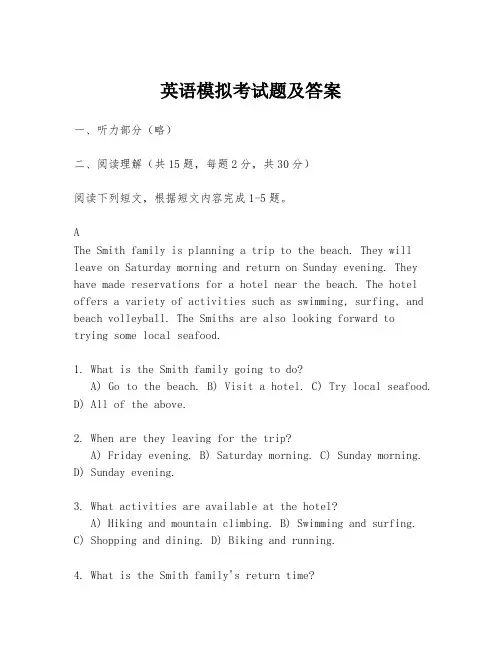
英语模拟考试题及答案一、听力部分(略)二、阅读理解(共15题,每题2分,共30分)阅读下列短文,根据短文内容完成1-5题。
AThe Smith family is planning a trip to the beach. They will leave on Saturday morning and return on Sunday evening. They have made reservations for a hotel near the beach. The hotel offers a variety of activities such as swimming, surfing, and beach volleyball. The Smiths are also looking forward totrying some local seafood.1. What is the Smith family going to do?A) Go to the beach. B) Visit a hotel. C) Try local seafood.D) All of the above.2. When are they leaving for the trip?A) Friday evening. B) Saturday morning. C) Sunday morning.D) Sunday evening.3. What activities are available at the hotel?A) Hiking and mountain climbing. B) Swimming and surfing. C) Shopping and dining. D) Biking and running.4. What is the Smith family's return time?A) Saturday evening. B) Sunday morning. C) Sunday evening.D) Monday morning.5. What is the main purpose of the Smith family's trip?A) To relax at the hotel. B) To participate in beach activities. C) To explore the local area. D) To enjoy the scenery.BThe local library is hosting a book fair next weekend. There will be a variety of books available at discounted prices.The fair will also feature guest authors who will be signing their books and giving talks. Refreshments will be providedfor visitors.6. What is the purpose of the book fair?A) To sell new books. B) To sell discounted books. C) To promote new authors. D) To provide refreshments.7. What special activities will be available at the book fair?A) Book signings and talks by authors. B) Book readingsand workshops. C) Book exchanges and auctions. D) Book clubs and discussion groups.8. When is the book fair taking place?A) This weekend. B) Next weekend. C) The following week. D) The weekend after next.9. What can visitors expect to find at the book fair?A) Only new releases. B) Only bestsellers. C) A variety of books. D) Only children's books.10. What will be provided for visitors at the book fair?A) Free books. B) Free refreshments. C) Free transportation. D) Free parking.CA new study has found that regular exercise can improve memory and cognitive function in older adults. The study involved participants who were asked to engage in moderate physical activity for 30 minutes a day, five days a week. After six months, the participants showed significant improvements in their memory and cognitive abilities.11. What is the main finding of the new study?A) Exercise can improve memory in older adults. B) Older adults should engage in strenuous exercise. C) Memory improves with age. D) Cognitive function declines with age.12. How long did the participants in the study exercise each day?A) 15 minutes. B) 30 minutes. C) 45 minutes. D) 60 minutes.13. How often did the participants exercise per week?A) Three times a week. B) Four times a week. C) Five times a week. D) Six times a week.14. What was the duration of the study?A) Three months. B) Six months. C) Nine months. D) One year.15. What improvements were observed in the participants after the study?A) Increased muscle strength. B) Improved cardiovascular health. C) Enhanced memory and cognitive function. D) Reduced body weight.三、完形填空(共10题,每题1.5分,共15分)(文章略)四、语法填空(共10题,每题1分,共10分)(文章略)五、短文改错(共10题,每题1分,共10分)(文章略)六、书面表达(共1题,30分)根据题目要求,写一篇不少于120词的短文。
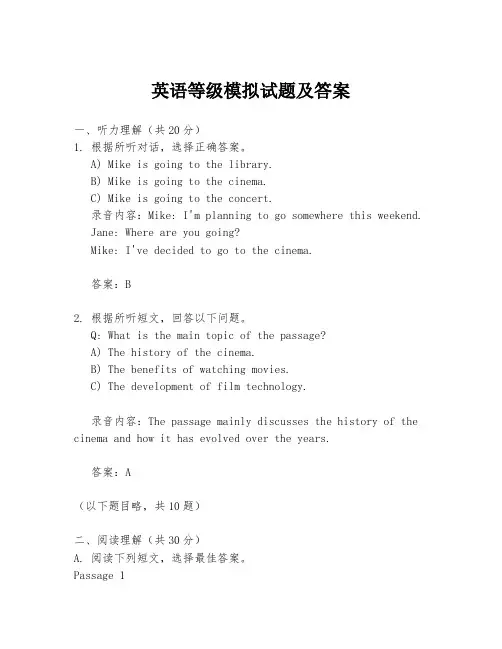
英语等级模拟试题及答案一、听力理解(共20分)1. 根据所听对话,选择正确答案。
A) Mike is going to the library.B) Mike is going to the cinema.C) Mike is going to the concert.录音内容:Mike: I'm planning to go somewhere this weekend. Jane: Where are you going?Mike: I've decided to go to the cinema.答案:B2. 根据所听短文,回答以下问题。
Q: What is the main topic of the passage?A) The history of the cinema.B) The benefits of watching movies.C) The development of film technology.录音内容:The passage mainly discusses the history of the cinema and how it has evolved over the years.答案:A(以下题目略,共10题)二、阅读理解(共30分)A. 阅读下列短文,选择最佳答案。
Passage 1In recent years, the popularity of online shopping has grown rapidly. People can buy almost everything online, from clothes to electronic devices.1. What is the main idea of the passage?A) Online shopping is convenient.B) People can buy everything online.C) The popularity of online shopping is increasing.答案:C2. What can people buy online according to the passage?A) Only clothes.B) Only electronic devices.C) Almost everything.答案:C(以下题目略,共5题)B. 阅读下列短文,判断正误。
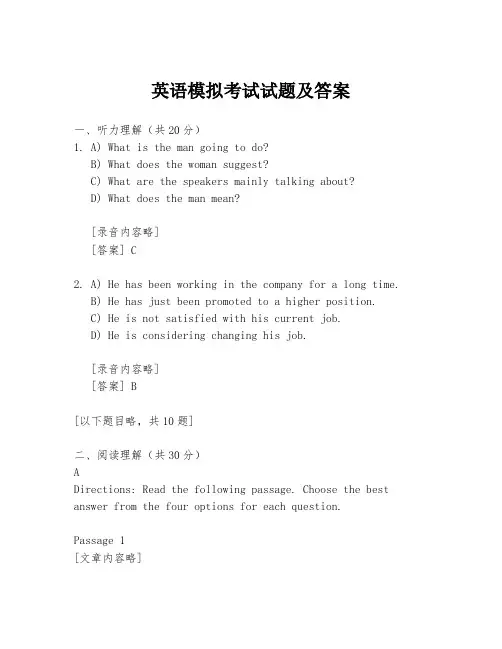
英语模拟考试试题及答案一、听力理解(共20分)1. A) What is the man going to do?B) What does the woman suggest?C) What are the speakers mainly talking about?D) What does the man mean?[录音内容略][答案] C2. A) He has been working in the company for a long time.B) He has just been promoted to a higher position.C) He is not satisfied with his current job.D) He is considering changing his job.[录音内容略][答案] B[以下题目略,共10题]二、阅读理解(共30分)ADirections: Read the following passage. Choose the best answer from the four options for each question.Passage 1[文章内容略]1. What is the main idea of the passage?A) The importance of education.B) The benefits of technology in education.C) The challenges faced by students.D) The role of technology in the future.[答案] B2. According to the passage, what does the author suggest?A) Students should rely less on technology.B) Technology should be integrated into education.C) The government should invest more in education.D) Teachers should be trained in using technology.[答案] B[以下题目略,共5题]BDirections: Read the following passage and answer thequestions by filling in the blanks with the appropriate words.Passage 2[文章内容略]1. The author believes that _______ is the key to success.[答案] hard work2. To achieve one's goals, one must have a _______ attitude.[答案] positive[以下题目略,共5题]三、完形填空(共20分)[文章内容略]1. A) despiteB) becauseC) althoughD) since[答案] A2. A) surprisedB) disappointedC) excitedD) confused[答案] B[以下题目略,共20题]四、语法填空(共10分)[文章内容略]1. The company has _______ (expand) its business to other countries.[答案] expanded2. She _______ (be) a teacher for ten years before she becamea writer.[答案] had been[以下题目略,共10题]五、短文改错(共10分)[文章内容略]1. 将“successful”改为“successfully”。
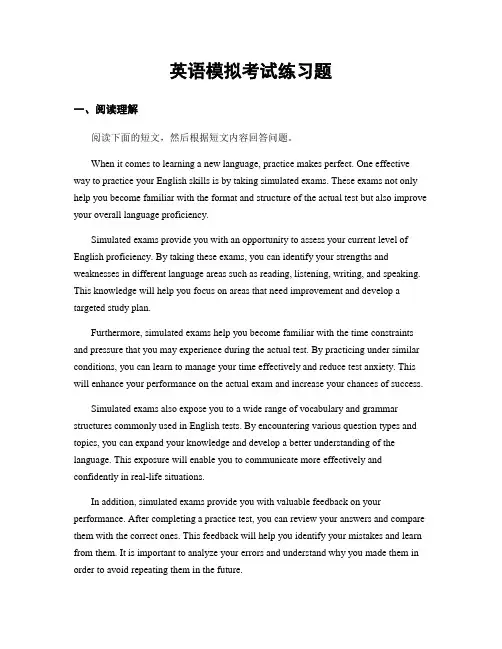
英语模拟考试练习题一、阅读理解阅读下面的短文,然后根据短文内容回答问题。
When it comes to learning a new language, practice makes perfect. One effective way to practice your English skills is by taking simulated exams. These exams not only help you become familiar with the format and structure of the actual test but also improve your overall language proficiency.Simulated exams provide you with an opportunity to assess your current level of English proficiency. By taking these exams, you can identify your strengths and weaknesses in different language areas such as reading, listening, writing, and speaking. This knowledge will help you focus on areas that need improvement and develop a targeted study plan.Furthermore, simulated exams help you become familiar with the time constraints and pressure that you may experience during the actual test. By practicing under similar conditions, you can learn to manage your time effectively and reduce test anxiety. This will enhance your performance on the actual exam and increase your chances of success.Simulated exams also expose you to a wide range of vocabulary and grammar structures commonly used in English tests. By encountering various question types and topics, you can expand your knowledge and develop a better understanding of the language. This exposure will enable you to communicate more effectively and confidently in real-life situations.In addition, simulated exams provide you with valuable feedback on your performance. After completing a practice test, you can review your answers and compare them with the correct ones. This feedback will help you identify your mistakes and learn from them. It is important to analyze your errors and understand why you made them in order to avoid repeating them in the future.To make the most out of simulated exams, it is essential to approach them with a positive mindset and a willingness to learn. Treat each practice test as an opportunity to improve and grow. Remember that mistakes are part of the learning process, and each error provides valuable insight into areas that require further attention.In conclusion, taking simulated exams is a beneficial way to enhance your English language skills. They allow you to assess your proficiency level, familiarize yourself with the test format, manage time effectively, expand your vocabulary and grammar knowledge, and receive feedback on your performance. By incorporating simulated exams into your language learning routine, you can boost your confidence and increase your chances of success in English exams.二、完型填空阅读下面的短文,然后根据短文内容选择最佳答案。
一、短对话(听力选择题)1. What are the speakers discussing?A.Cultural differences. B.Entertainment. C.Languages.2. What is the man?A.A shop assistant. B.A tailor. C.A doctor.3. Why does the man refuse to go to the gym?A.He will fly to the US. B.He will book a hotel. C.He will meet his friend.4. What do we know about John?A.He likes doing sports. B.He rides a bike toschool.C.He plans to read anovel.5. What is the man dissatisfied with about the performance?A.Its costumes. B.Its set. C.The actors.二、长对话(听力选择题)6. 听下面一段较长对话,回答以下小题。
1. What is the probable relationship between the speakers? A.Father and daughter. B.Teacher and student. C.Classmates.2. What does the woman want to become?A.A security guard. B.A computer securityexpert.C.A computer scienceteacher.3. What does the man suggest the woman do?A.Do well in math. B.Major in math. C.See math as a career.7. 听下面一段较长对话,回答以下小题。
【模拟】2023最新英语模拟试卷及答案
(经典题库+可打印)
为了帮助学生备考英语,我们特别准备了一份2023最新英语
模拟试卷及答案。
这套试卷包含经典题库,并且可以打印出来。
以
下是试卷的简要概述:
本套试卷包含多篇阅读理解文章,每篇文章后面有对应的题目,供学生进行练和答题。
题目包括选择题、判断题以及填空题。
完型填空(Cloze Test)
完型填空是英语考试中常见的一个部分,我们的试卷中也包含
了这一部分的练题目。
学生需要根据文章内容,在空白处选择合适
的单词或短语填入。
在英语考试中,听力理解是一个重要的部分。
我们的试卷中提
供了多段听力材料,并附有相应的问题。
学生需要仔细听录音并回
答问题。
写作(Writing)
写作是培养学生英语表达能力的重要环节。
我们的试卷中包含了写作题目,学生需写出合适的文章或短文。
以上是本套2023最新英语模拟试卷的简要介绍。
我们希望通过这份试卷和答案,能够帮助学生们更好地备考英语。
祝愿大家取得优秀的成绩!
请注意,该文档仅供参考,具体内容以实际试卷为准。
---
请注意,以上内容仅供参考,具体内容以实际试卷为准。
英语模拟卷试题及答案一、选择题(共20分,每题2分)1. What is the capital of France?A. LondonB. ParisC. RomeD. Berlin答案:B2. Which of the following is not a fruit?A. AppleB. OrangeC. CarrotD. Banana答案:C3. The phrase "break a leg" is used to:A. Wish someone bad luckB. Wish someone good luck in a performanceC. Ask someone to sit downD. Apologize for a mistake答案:B4. Fill in the blank: He is ________ to play the guitar.A. enough oldB. old enoughC. enough youngD. young enough答案:B5. The word "bibliophile" refers to a person who:A. Loves to read booksB. Writes booksC. Publishes booksD. Sells books答案:A6. Which of the following is not a verb?A. RunB. JumpC. FastD. Swim答案:C7. The opposite of "humble" is:A. ArrogantB. ModestC. GenerousD. Humorous答案:A8. In a sentence, the subject is usually:A. The person or thing that performs the actionB. The action itselfC. The result of the actionD. The location of the action答案:A9. What does the acronym "NASA" stand for?A. National Aeronautics and Space AdministrationB. National Association of Sports and AthleticsC. National Association of Science and AstronomyD. National Association of Science and Astronomy答案:A10. The idiom "bite the bullet" means to:A. Literally bite a bulletB. Face a difficult situation bravelyC. Give up on somethingD. Take a break答案:B二、填空题(共20分,每题2分)1. The ________ of the United States is Washington, D.C.答案:capital2. The chemical symbol for water is ________.答案:H2O3. The phrase "________" means to be very careful.答案:on tenterhooks4. The word "________" is used to describe a person who is very talkative.答案:loquacious5. The opposite of "north" is ________.答案:south6. The verb "________" means to make something more complex.7. The phrase "________" is used to describe a situation where someone is in a difficult position.答案:between a rock and a hard place8. The word "________" refers to a person who is very knowledgeable.答案:savant9. The opposite of "extrovert" is ________.答案:introvert10. The verb "________" means to make something more simple. 答案:simplify三、阅读理解(共30分,每题3分)阅读下面的文章,然后回答问题。
2024年上海英语听说模拟试题、2024 Shanghai English Listening and Speaking Simulation TestPart I: Listening ComprehensionSection 1: Short ConversationsDirections: In this section, you will hear some short conversations. At the end of each conversation, a question will be asked about what was said. Choose the best answer to each question.1. A. FridayB. SaturdayC. SundayD. Thursday2. A. In a shopB. At a restaurantC. In a libraryD. At a bus stop3. A. $15B. $50C. $30D. $20Section 2: PassagesDirections: In this section, you will hear some passages. At the end of each passage, you will hear some questions. Choose the best answer to each question.4. What is the speaker mainly talking about?A. His job experienceB. His favorite hobbyC. His travel plansD. His family history5. What is the likely relationship between the two speakers?A. FriendsB. ColleaguesC. Teacher and studentD. Customer and shopkeeper6. Why is the woman calling the man?A. To invite him to a partyB. To ask for his helpC. To complain about a productD. To discuss a work projectPart II: SpeakingSection 1: Personal IntroductionDirections: In this section, you will introduce yourself. Talk about your name, where you are from, your hobbies, and your future plans.Section 2: Giving OpinionsDirections: In this section, you will be given a topic to discuss. Express your opinions and give reasons to support them.Topic: Should schools require students to wear uniforms?Section 3: Describing a PictureDirections: In this section, you will be shown a picture. Describe what you see in the picture and discuss its significance.Overall, the 2024 Shanghai English Listening and Speaking Simulation Test aims to assess the students' ability tocomprehend spoken English and communicate effectively in English. Good luck to all the test takers!。
英语阅读模拟试题及答案一、阅读理解阅读下列短文,从每题所给的四个选项(A、B、C和D)中,选出最佳选项。
A篇In the past few years, the popularity of online learning has grown rapidly. Many people are now taking advantage of the convenience and flexibility that online courses offer. Here are some of the reasons why online learning is becoming increasingly popular.1. Time-saving: Online courses can be accessed at any time, allowing students to learn at their own pace without the constraints of a traditional classroom schedule.2. Cost-effective: Online courses are often less expensive than their on-campus counterparts, making education more accessible to a wider range of students.3. Flexibility: Students can complete coursework from anywhere with an internet connection, which is especially beneficial for those who have work or family commitments.4. Diversity of courses: Online platforms offer a wide variety of courses, catering to different interests andcareer paths.According to a recent survey, 79% of students believe that online learning is more convenient than traditional classroom learning.Questions:21. What is the main idea of the passage?A. The cost of online courses.B. The benefits of online learning.C. The drawbacks of traditional education.D. The future of online education.22. What percentage of students think online learning is more convenient?A. 79%B. 51%C. 65%D. 85%23. What is one advantage of online learning mentioned in the passage?A. It requires less time.B. It is more expensive.C. It offers fewer course options.D. It is limited to on-campus students.Answer Key:21. B22. A23. AB篇The city of London is known for its rich history and cultural landmarks. One of the most famous attractions is the Tower of London, which has a history dating back to the 11th century. The tower has served various purposes over the years, including a royal palace, a prison, and a place where the Crown Jewels of England are kept.Visitors to the Tower of London can explore the medieval palace, the White Tower, which houses the Royal Armouries collection. They can also see the Crown Jewels, which include the Imperial State Crown and other regalia worn by British monarchs.The Tower of London is not just a historical site; it is also home to the famous Beefeaters, who are the ceremonial guards of the tower. These guards, known for their distinctive uniforms, have a long-standing tradition of guarding the tower and its treasures.Questions:24. What is the main purpose of the passage?A. To describe the history of the Tower of London.B. To advertise the Tower of London as a tourist attraction.C. To explain the role of the Beefeaters.D. To list the different uses of the Tower of London.25. What can visitors see at the Tower of London?A. The Royal Armouries collection.B. The British Parliament.C. The Changing of the Guard ceremony.D. The Houses of Parliament.26. Who are the Beefeaters?A. Ceremonial guards of the tower.B. Tour guides at the tower.C. Members of the British royal family.D. Performers in traditional uniforms.Answer Key:24. D25. A26. A二、完形填空Read the following passage and fill in the blanks with the appropriate words from the box below. Each word can only be used once.A young boy was walking along the beach when he noticed thousands of starfish on the sand, stranded after the tide had gone out. He began to pick them up one by one and throw them back into the sea. An old man watched him for a while and then asked, "Why are you doing that? There are so many of them, and you can't save them all."The boy looked at the old man and said, "I can't save them all, but I can make a difference to this one," and he threw another starfish into the sea.The old man was moved by the boy's actions and decided to help him. Together, they saved many starfish that day.Words:- difference- noticed- asked- moved- together- tide27. He ______ the starfish on the sand.28. The starfish were stranded after the ______ had gone out.29. The old man ______ the boy and then spoke to him.30. "I can't save them all, but I can make a ______ to this one," said the boy.31. The old man was ______ by the boy's actions.32. They worked ______ and saved many starfish.Answer Key。
英语试题模拟卷及答案一、听力理解(共20分)1. 听下面对话,选择正确答案。
A. 去图书馆B. 去公园C. 去电影院正确答案:A2. 听下面对话,选择正确答案。
A. 8:00B. 9:00C. 10:00正确答案:B3. 听下面对话,选择正确答案。
A. 老师B. 医生C. 工程师正确答案:C4. 听下面对话,选择正确答案。
A. 红色B. 蓝色C. 绿色正确答案:A5. 听下面对话,选择正确答案。
A. 5天B. 7天C. 10天正确答案:B二、阅读理解(共30分)阅读下面短文,回答6-10题。
Last weekend, I went to the beach with my family. We had a great time playing in the sand and swimming in the sea. My sister collected many beautiful shells. My brother built a big sandcastle. In the evening, we had a barbecue on the beach and watched the sunset. It was a wonderful day.6. What did the author do last weekend?正确答案:Went to the beach with family.7. What did the author's sister do at the beach?正确答案:Collected shells.8. What did the author's brother do at the beach?正确答案:Built a sandcastle.9. What did they do in the evening?正确答案:Had a barbecue and watched the sunset.10. How did the author feel about the day?正确答案:It was a wonderful day.三、完形填空(共20分)阅读下面短文,从每题所给的选项中选择正确答案。
2011成人高考(高起点)英语模拟试题及答案一.(考试时间120分钟)一、语音知识(共5小题;每题1.5分,共7.5分。
)在下列每组单词中,有一个单词的划线部分与其他单词的划线部分的读音不同。
找出这个词,并把它前面的大写字母填入左边括弧里。
( )1.A. machine B. dictionary C. Russian D. question( )2.A. popular B. large C. remarkable D. dark( )3.A. church B. chalk C. character D. cheat( )4.A. cheat B. weak C. increase D. area( )5.A. copy B. loudly C. today D. Monday二、词汇与语法知识(共25小题;每题1.5分,共37.5分。
)从每小题的四个选择项中,选出最佳的一项,并把它前面的大写字母填入左边的括弧里。
( )6.—The sea is very rough today.—Yes,I…ve never seen _______ before.A. such rough seaB. such a rough seaC. so rough seaD. that rough sea( )7.—She…s broken her arm again.—Again? I ______ she _______ ever broken it before.A. don…t know; hasB. didn‟t know; hadC. didn…t know; hasD. hadn‟t know; wo uld( )8.—Has the wallet been returned yet?—No,but we expect ______ any day now.A. to return itB. it to returnC. it to be returnedD. it returned( )9.—I…ve been told to pay the rent.—But it…s already been paid. It ______ by someone else.A. must beB. may beC. must be paidD. must have been paid( )10. Montreal is larger than _______ in Canada.A. any cityB. any citiesC. any other citiesD. any other city( )11. Human…s brains are larger in proportion to their bodies than _______.A. whalesB. a whaleC. that of whalesD. those of whales( )12. Before writing your article,______,collect your material,and prepare an outline.A. a topic should be selectedB. a topic to be selectedC. your topic should be selectedD. select a topic( )13.—I usually travel by train.—Why not ________ by plane for a change?A. to try goingB. trying to goC. to try and goD. try going( )14. The boy lay in the street,his eyes _______ and his hands ______.A. closing; tremblingB. closed; trembledC. closing; trembledD. closed; trembling( )15. He _______ here for 20 years by the end of next month.A. had workedB. has workedC. will have workedD. will work( )16. I…ll do _______ the doctor advised.A. asB. likeC. thatD. all what( )17.—Did we have to wait for Tom?—Well,_______ very angry if we hadn…t waited for him.A. he…d have beenB. he wereC. he had beenD. he must be( )18. Why do you insist on ________?A. this to be doneB. this doneC. this being doneD. this is done( )19. We looked everywhere for the ________.A. missing watchB. missed watchC. watch being missedD. watch that lost( )20. ______,the runners crossed the finish line.A. TiringB. TiredC. To be tiredD. They are tired( )21. _______ by the air,the kite went up into the sky.A. PushingB. PushedC. Having been pushedD. Having pushed( )22.—The round bowl over there is a bit small,isn…t it?— _______.A. So are the fishB. So the fish areC. Neither the fishD. Neither are the fish( )23. She couldn…t take shorthand,_______ slowed down the work of the office.A. thatB. whichC. itD. so( )24. Was it last Friday ________ you met him?A. thatB. on whichC. whichD. when( )25. _______ might fail in the exam worried him.A. HeB. That heC. WhatD. It( )26.—I…v got this really painful ear.—How long _______ you?A. does it botherB. was it botheringC. would it botherD. has it been bothering( )27.—I started to study,but then a friend called.—That…s no excuse ________.A. for not studyingB. not for studyingC. not studyingD. not to studying( )28.—Why was he so hot when he got home?—He ________.A. was runningB. is runningC. has been runningD. had been running( )29.—There…s been an earthquake.—I know. At least a hundred people ________.A. were to be killedB. are said to have been killedC. said to have been killedD. are said to kill( )30. You may invite _______ wants to go.A. whomeverB. whoeverC. which oneD. people三、完形填空(共20小題;每題1.5分,共30分。
)通读下面的短文,掌握其大意。
从每小题的四个选项中选出可填入相应空白处的最佳选择,并把它前面的大写字母填入左边括号里。
Mr. Jones woke early one morning,before the sun had risen. It was a beautiful morning,_31_ he went to the window and looked out. He was _32_ to see a neatly-dressed and mid-aged professor,who _33_ in the university just up the road from Mr. Jones… house,coming the direction of the town. He had grey hair thick glasses,and was _34 an umbrella,a morning newspaper and a bag. Mr. Jones thought thathe must have _35_ by the night train _36_ taking a taxi.Mr. Jones had a big tree in his garden,and the children had tied a long _37_ to one of the branches,so that they could swing on it.Mr. Jones saw the professor _38_ when he saw the rope and looked carefully up and down the road. When he saw that there was _39_ in sight,he stepped into the garden (there was no fence),put his umbrella,newspaper,bag and hat nearly on the grass and _40_ the rope. He pulled it _41_ to see whether it was strong enough to take his weight,then ran as fast as he could and swung into the _42_ on the end of the rope,his grey hair blowing all around _43_. _44_ he swung,sometimes taking a few more _45_ steps on the grass when the rope began to swing _46_ slowly for him._47_ the professor stopped,straightened his tie,combed his hair carefully,put on his hat,_48_ his umbrella,newspaper and bag,and continued _49_ his way to the university,looking as _50_ and correct and respectable as one would expect a professor to be.( )31.A. because B. as C. so D. for( )32.A. surprised B. glad C. worried D. excited( )33.A. studied B. worked C. stayed D. lived( )34.A. passing B. doing C. carrying D. sending( )35.A. left B. gone C. taken D. arrived( )36.A. because of B. instead of C. by D. with( )37.A. rope B. line C. stick D. ruler( )38.A. run B. walk C. jump D. stop( )39.A. nothing B. nobody C. no room D. no house( )40.A. carried B. grasped C. took D. threw( )41.A. hard B. high C. heavily D. greatly( )42.A. garden B. tree C. land D. air( )43.A. hands B. his shoulders C. his face D. his neck( )44.A. Backwards and forwards B. Up and downC. Left and rightD. Around and around( )45.A. running B. stopping C. rising D. falling( )46.A. enough B. more C. too D. less( )47.A. At first B. At last C. At once D. At least( )48.A. set up B. gave up C. send up D. picked up( )49.A. on B. for C. by D. with( )50.A. clean B. slow C. funny D. quiet四、阅读理解(共15小题;每题2分,共30分。